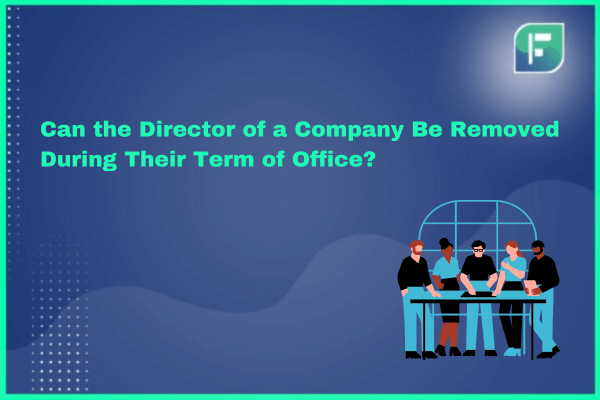A director plays an essential part in the ever-changing world of governance for corporations. Director of a company has a great deal of duty, which includes anything from making managerial choices to making sure regulations are followed. Nevertheless, situations sometimes occur where a director of the company is removed despite their notoriety. This poses a vital query: Is it possible to dismiss a corporate director while they are serving in that capacity? Let us examine the regulatory context of this matter.
Who is called a Director?
A person nominated to a company’s board of directors is commonly referred to as a “director” under the provisions of the Companies Act. A director is defined under the Company Act as an individual who holds the title of director under any name that may be known. It contains every person who was officially selected to serve on the board, including independent, not-for-profit, and chief executives. The Companies Act’s Sections 149 through 196 mostly contain the rules for shareholders.
Role of the Board in the Removal of Director of a Company
In general, a director of the company can be removed by the board of directors or the stockholders, as specified within the bylaws or articles of association of the company in question. Usually, the procedure includes calling an assembly for a vote on the dismissal. Although the criteria for dismissal differ based on the jurisdiction and the organization’s rules and regulations, it generally requires an absolute majority or supermajority vote.
Reasons for Termination or Removal of a Director in a Company Legal requirements for companies and the articles of association frequently specify the reasons for the director of the company to be removed. Standards may differ, but the following are typical grounds for elimination:
- Infringement of Fiduciary Duty- The director has obligations towards the corporation that include the responsibilities of care, faithfulness, and decent faith. Removal may be necessary if the misconduct, conflicts of interest, or carelessness constitute breaches of these obligations.
- Misconduct or Mismanagement- Stakeholders or the board of directors may request the director of the company be removed if they participate in misbehavior or incompetence that jeopardizes the well-being of the company.
- Lack of Trust- A request for dismissal may arise if stockholders or the board of directors begin to have doubts about the director’s capacity to carry out their responsibilities.
- Breach of Contract- A Director of a company may be removed from their position if they fail to uphold the terms of their contracts or the rules and regulations of the company.
Ballot Fights and Investor Activism in a Company
In listed corporations, activist shareholders can have a bearing on the removal of directors. If the directors of the company are removed because they think they are unsuitable or ineffective, investors may start proxy fights or put up motions. Financial institutions and vote consulting companies frequently take notice of such initiatives, putting pressure on board members to take action in the best interest of stakeholders.
Statutory Procedures and Limitations
Significant aspects that need careful analysis are the statutory procedures and difficulties related to the Director of a company to be removed while they are serving in that capacity. Following is a more detailed:
Fair and Due Procedure
The notion of proper process is essential to the removal procedure since it guarantees that the concerned director receives fair consideration plus a chance to address the charges made contrary to them.
Compliance with Company Governance Criteria
When evaluating the Director of a company to be removed, company are required to follow the most efficient practices and defined governance rules. These criteria frequently include rules about the make-up of the board, the impartiality of the directors, and the protocols for resolving issues of interest.
Evaluation of Governance Documents
To comprehend the protocols and prerequisites for the Director of a company to be removed, it is crucial to study the corporation’s articles of organization and bylaws, including any pertinent contracts for starting the termination process.
Legal Action and Judicial Challenges
If a director feels that their removal was unfair or illegal, there may be a chance that they will face legal challenges and litigation following their removal. Legal problems may raise claims of procedural denial, fiduciary duty incidents, and corporate law infractions.
How to Remove a Director of a Company?
Follow the steps given below in order to remove the director of the company:
- Call a board meeting in order to take decision regarding the removal of the directory of a company
- Pass resolution regarding the same by following the proper procedure
- Serve special notice to the director of the company
- Convene general meeting if needed.
- File required forms for the purpose of removal of director of company
- Update company records with respect to the same
- Notify concerned parties regarding the same decision of the removal of the director of the company
- Handover responsibilities to the new director
- Issue termination letter for the diretor whom you are removing
- Ensure compliance with the other provision of the company law.
Conclusion
The question is not easy to answer if a Director of a company can be removed while they are serving in that capacity. Although removal methods are provided by legal rules and regulations and company governance rules. To reduce hazards and keep stakeholders’ confidence, businesses must remove directors with rigor, openness, and respect for proper procedures. Corporations may guarantee the removal of the director of the company to be removed are carried out in a just, open, and ethical way by adhering to the strictest requirements for business ethics and by obeying every regulation. In the end, it is essential to handle director withdrawals with caution, candor, and respect for the law. Sustaining credibility, long-term viability, and confidence in business ecosystems requires striking a balance between stakeholder priorities and business governance norms.






